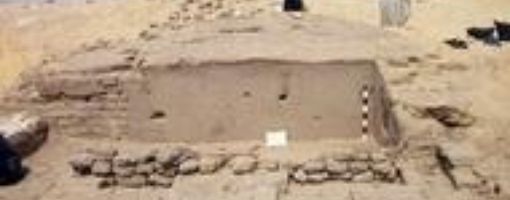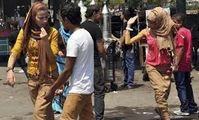Archaeologists Discover a Tomb of Ptahmes in Egypt

Created: Jun 01, 2010,
modified: Jan 13, 2012,
overall rating: 0.000
Egypt (Saqqara) - The Archaeology faculty at Cairo University has discovered a new tomb at Saqqara. The mission uncovered the tomb of Ptah Mes, arm leader and royal scribe, in the 19th dynasty cemetery of top governmental officials, which is located at the southern side of the ramp of king Unas’ pyramid in Saqqara.
Culture minister Farouk Hosni announced the discovery today adding that the tomb can be dated to the second half of the 19th dynasty (1203-1186 BC).
Dr. Zahi Hawass, Secretary General of the Supreme Council of Antiquities (SCA), explained that the tomb is 70m long and composed of a number of corridors and chapels. This tomb design is similar to the tomb of Ptah Im Wiya, the royal seal bearer, who lived during the reign of king Akhenaten. A Dutch mission discovered Ptah Im Wiya’s tomb at Saqqara in 2007.
Dr. Ola El-Egezi, former Dean of the Faculty of Archaeology at Cairo University, said that the owner of the tomb is a prominent figure as he was appointed to several governmental posts, including the inherited prince, the royal scribe and the supervisor of Ptah temple. She continued that excavations also revealed several stelae. Among them is an unfinished stela engraved with a scene featuring the deceased and his family before the Theban triad: Amun, Mut and Khonsu. Such a stelae, El-Egezi said, reveals that during the second half of the 19th dynasty, the cult of Amun was revived.
Deputy of the mission, Dr. Ahmed Saeed, said that during the excavations several fragments of a statue of the tomb’s owner and his wife were unearthed. A painted head that most probably belongs to his wife or one of his daughters has also been discovered along with a lower part of a limestone statue that belongs to the deceased. Clay vessels, shawbti figurines and amulets have also been found within the sand.
Dr. Heba Mustafa, another member of the mission, said that pillars of this tomb were reused during the Christian era to build chapels. The tomb was also subjected to robbery in the 19th century, which lead to the deterioration of some of its walls. Several pieces of the wall were found within the debris inside the tomb. Mustafa said that all of these pieces were collected in order to be restored and registered.
Excavations will continue at the tomb of Ptah Mes in an attempt to find the main shaft of the tomb, which will lead to the burial chamber where the deceased’s sarcophagus and his funerary equipment were placed.
Global Arab Network
Culture minister Farouk Hosni announced the discovery today adding that the tomb can be dated to the second half of the 19th dynasty (1203-1186 BC).
Dr. Zahi Hawass, Secretary General of the Supreme Council of Antiquities (SCA), explained that the tomb is 70m long and composed of a number of corridors and chapels. This tomb design is similar to the tomb of Ptah Im Wiya, the royal seal bearer, who lived during the reign of king Akhenaten. A Dutch mission discovered Ptah Im Wiya’s tomb at Saqqara in 2007.
Dr. Ola El-Egezi, former Dean of the Faculty of Archaeology at Cairo University, said that the owner of the tomb is a prominent figure as he was appointed to several governmental posts, including the inherited prince, the royal scribe and the supervisor of Ptah temple. She continued that excavations also revealed several stelae. Among them is an unfinished stela engraved with a scene featuring the deceased and his family before the Theban triad: Amun, Mut and Khonsu. Such a stelae, El-Egezi said, reveals that during the second half of the 19th dynasty, the cult of Amun was revived.
Deputy of the mission, Dr. Ahmed Saeed, said that during the excavations several fragments of a statue of the tomb’s owner and his wife were unearthed. A painted head that most probably belongs to his wife or one of his daughters has also been discovered along with a lower part of a limestone statue that belongs to the deceased. Clay vessels, shawbti figurines and amulets have also been found within the sand.
Dr. Heba Mustafa, another member of the mission, said that pillars of this tomb were reused during the Christian era to build chapels. The tomb was also subjected to robbery in the 19th century, which lead to the deterioration of some of its walls. Several pieces of the wall were found within the debris inside the tomb. Mustafa said that all of these pieces were collected in order to be restored and registered.
Excavations will continue at the tomb of Ptah Mes in an attempt to find the main shaft of the tomb, which will lead to the burial chamber where the deceased’s sarcophagus and his funerary equipment were placed.
Global Arab Network
Your Rating:
Overall rating: 0.000
Totally voted: 0
Comments
Login/Registration
Weather in:
Exchange Rates
1 USD = 16.200 LE
1 EUR = 18.040 LE
News
-
IMF loan expected next month
Apr 22, 2013, rating: 3.000, 3 votes Egypt may secure an International Monetary Fund loan agreement in about amonth, state news agency MENA reported, quoting "informed" sources ...
Egypt may secure an International Monetary Fund loan agreement in about amonth, state news agency MENA reported, quoting "informed" sources ...
-
Egypt received 11 million tourists in 2012 and aims to boost that number to 14 million in 2013.
Jan 22, 2013, rating: 3.000, 2 votes
Egypt received 11 million tourists in 2012 and aims to boost that number to 14 million in 2013.
-
Egypt limits travelers leaving country to US$10,000 in cash
Dec 26, 2012, rating: 3.250, 4 votes Egypt has banned travelers from carrying more than US$10,000 in foreigncurrency cash in or out of the country ...
Egypt has banned travelers from carrying more than US$10,000 in foreigncurrency cash in or out of the country ...
-
National Coalition on Climate Change for Egypt is born
Nov 30, 2012, rating: 5.000, 1 votes The global COP18 conference on climate change opens in Doha Monday.About 17,000 participants from all over the world ...
The global COP18 conference on climate change opens in Doha Monday.About 17,000 participants from all over the world ...
-
Egyptian family's average annual income is LE25,000, agency reports.
Nov 29, 2012, rating: 5.000, 1 votes The average annual Egyptian household income during 2010-2011 wasLE25,353, according to the Central Agency for Public Mobilization andStatistics.
The average annual Egyptian household income during 2010-2011 wasLE25,353, according to the Central Agency for Public Mobilization andStatistics.
-
Judgment for sexual harassment
Nov 14, 2012, rating: 3.600, 5 votes A man was sentenced to two years in prison and fined LE 2,000 for sexually harassing a woman, an ...
A man was sentenced to two years in prison and fined LE 2,000 for sexually harassing a woman, an ...








